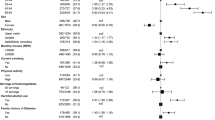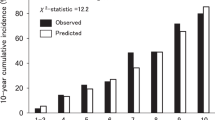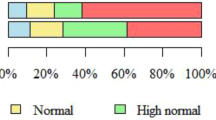Abstract
To date only a small number of studies have investigated the pattern of associations within a set of hypertension risks. The objective of this study was therefore to examine the interrelation of main hypertension risks in an African population by using factor analysis in order to detect underlying risk patterns. Subjects aged 16–70 years (N=963) were recruited from 37 randomly selected sites throughout the North West Province during 1996–1998. Exclusion criteria were pregnancy, lactation, casual visitors, drunkenness and treatment for chronic diseases, such as hypertension. Subjects with blood pressures exceeding 140/90 mmHg were classified as hypertensive. Children aged 10–15 years were also recruited from 30 randomly selected schools during 2000–2001 (N=694). Children were classified as hypertensive when an average systolic or diastolic blood pressure greater than or equal to the 90th percentile for age and sex was encountered, while correcting for height. The following hypertension risks were measured: urbanisation, obesity, plasma fibrinogen, lipids, insulin, serum gamma glutamyl-transferase, dietary intake, smoking and alcohol consumption.
From 23 risks the factor analysis disclosed five factors that explained 56.2% of the variance in the male and 43.5% of the variance in the female group: an urban malnutritional phenomenon, the metabolic syndrome X, a hypercholesterolaemic and obesity complex, an alcoholic hypertriglyceridaemia, and central and peripheral cardiovascular hypertensive effects. In conclusion, South Africans migrating from rural to urban areas adapt to a new lifestyle with numerous risks, resulting in conditions like malnutrition, the metabolic syndrome X, dyslipidaemia, alcoholism, obesity and increased peripheral vascular resistance. For successful prevention of hypertension in a population in transition, a whole risk pattern should be corrected, rather than an individual risk by implementing lifestyle modification programmes.
This is a preview of subscription content, access via your institution
Access options
Subscribe to this journal
Receive 12 digital issues and online access to articles
$119.00 per year
only $9.92 per issue
Buy this article
- Purchase on Springer Link
- Instant access to full article PDF
Prices may be subject to local taxes which are calculated during checkout

Similar content being viewed by others
References
World Health Organisation. International Society of Hypertension Guidelines for the Management of Hypertension. J Hypertens 1999; 17: 151–183.
World Health Organization. World Health Statistics Annual. World Health Organization: Geneva, 1995.
Van Rooyen JM et al. An epidemiological study of hypertension and its determinants in a population in transition: the THUSA study. J Hum Hypertens 2000; 14: 779–787.
Stampfer MJ et al. A prospective study of cholesterol, apolipoproteins, and the risk of myocardial infarction. N Engl J Med 1991; 325: 373–381.
Appel LJ et al. A clinical trial of the effects of dietary patterns on blood pressure. N Engl J Med 1997; 336: 1117–1124.
Marušič A . Factor analysis for coronary heart disease: an independent replication. Int J Cardiol 2000; 75: 233–238.
Wright L, Carbonari J, Voyles W . A factor analytic study of physical risk variables for CHD. J Clin Psychol 1992; 48: 165–170.
Opie LH . The Heart Physiology from Cell to Circulation. Lippincott-Raven Publishers: Philadelphia, 1998.
Doll R et al. Mortality in relation to smoking: 40 years' observations on male British doctors. BMJ 1994; 309: 901–911.
Wannamethee SG, Shaper AG . Patterns of alcohol intake and risk of stroke in middle-aged British men. Stroke 1996; 27: 1033–1039.
Gordon DJ et al. High-density lipoprotein cholesterol and cardiovascular disease: four prospective American studies. Circulation 1989; 79: 8–15.
Law MR, Wald NJ, Thompson SG . By how much and how quickly does reduction in serum cholesterol concentration lower risk of ischaemic heart disease? BMJ 1994; 308: 367–373.
Rimm EB et al. Body size and fat distribution as predictors of coronary heart disease among middle-aged and older US men. Am J Epidemiol 1995; 141: 1117–1127.
Franklin SS et al. Is pulse pressure useful in predicting risk for coronary heart disease? The Framingham Heart Study. Circulation 1999; 100: 354–360.
Stamler J et al. Relationship to blood pressure of combinations of dietary macronutrients. Findings of the Multiple Risk Factor Intervention Trial (MRFIT). Circulation 1996; 94: 2417–2423.
Stamler J et al. Inverse relationship between dietary protein markers and blood pressure of individuals: findings for 10 020 men and women — the INTERSALT study. Circulation 1996; 94: 1629–1733.
He J, Whelton PK . Effect of dietary fiber and protein intake on blood pressure: a review of epidemiologic evidence. Clin Exp Hypertens 1999; 21: 785–796.
Kaplan NM . The dietary guideline for sodium: should we shake it up? No. Am J Clin Nutr 2000; 71: 1020–1026.
Vorster HH . Fibrinogen and women's health. Thromb Res 1999; 95: 137–154.
James S et al. Nutritional status influences plasma fibrinogen concentration: evidence from the THUSA survey. Thromb Res 2000; 98: 383–394.
Ernst E, Resch KL . Fibrinogen as a cardiovascular risk factor: a meta-analysis and review of the literature. Ann Intern Med 1993; 118: 956–963.
Despres J-P et al. Hyperinsulinemia is an independent risk factor for ischemic heart disease. N Engl J Med 1996; 334: 952–957.
Vorster HH et al. The impact of urbanization on physical, physiological and mental health of Africans in the North West Province of South Africa: the THUSA study. S Afr J Sci 2000; 96: 505–514.
National High Blood Pressure Education Program Working Group on Hypertension Control in Children and Adolescents. Update on the 1987 Task Force Report on High Blood Pressure in Children and Adolescents: a working group report from the National High Blood Pressure Education Program. Pediatrics 1996; 98: 649–658.
Wesseling KH, Settels JJ, De Wit B . The measurement of continuous finger arterial pressure noninvasively in stationary subjects. In: Schmidt TH, Dembroski TM, Blümchen G (eds). Biological Factors in Cardiovascular Disease. Springer: Berlin, 1986, pp 355–375.
Silke B, McAuley D . Accuracy and precision of blood pressure determination with the Finapres: an overview using re-sampling statistics. J Hum Hypertens 1998; 12: 403–409.
Wesseling KH, Jansen JRC, Settels JJ, Schreuder JJ . Computation of aortic flow from pressure in humans using a nonlinear, three-element model. J Appl Physiol 1993; 75: 2566–2673.
Norton K, Olds T . Anthropometrica: A Textbook of Body Measurement for Sports and Health Courses. UNSW Press: Sydney, 1996.
Boileau RA, Lohman TG, Slaughter MH . Exercise and body composition of children and youth. Scand J Sport Sci 1985; 7: 17–27.
Vorster HH, Walker ARP, Odendaal I, Kruger HS . Validation of a dietary intake questionnaire for use in South Africa inter-ethnic populations. XIII International Congress of Nutrition; Brighton, UK, 1985.
MacIntyre UE . Dietary intakes of Africans in transition in the North West Province. PhD thesis, Potchefstroom University for Christian Higher Education, 1998.
Simons-Morton DG, Obarzanek E . Diet and blood pressure in children and adolescents. Pediatr Nephrol 1997; 11: 244–249.
Falkner B, Sherif K, Michel S, Kushner H . Dietary nutrients and blood pressure in urban minority adolescents at risk for hypertension. Arch Pediatr Adolesc Med 2000; 154: 918–922.
Hajjar IM, Grim CE, George V, Kotchen TA . Impact of diet on blood pressure and age-related changes in blood pressure in the US population. Arch Intern Med 2001; 161: 589–593.
Langenhoven M, Kruger M, Gouws E, Faber M . MRC Food Composition Tables. Medical Research Council: Tygerberg, SA, 1991.
StatSoft, Inc. STATISTICA for Windows (Computer Program Manual). StatSoft: Inc: Tulsa, OK, 2000.
Joliffe IT, Morgan BJ . Principal component analysis and exploratory factor analysis. Stat Methods Med Res 1992; 1: 69–95.
Hansen BC . The metabolic syndrome X. Ann NY Acad Sci 1999; 892: 1–24.
Reaven GM . Role of insulin resistance in human disease (syndrome X): an expanded definition. Annu Rev Med 1993; 44: 121–131.
Mariotti F, Huneau JF, Tomé D . Dietary protein and cardiovascular risk. J Nutr Health Aging 2001; 5: 200–204.
Dwyer JT . Health aspects of vegetarian diets. Am J Clin Nutr 1988; 48: 712–738.
Burket V, Beilin LJ . Vegetarian diets and high blood pressure: an update. Nutr Metab Cardiovasc Dis 1994; 4: 103–112.
Liu K, Ruth KJ, Shekelle RB, Stamler J . Macronutrients and long-term change in systolic blood pressure. Circulation 1993; 87: 679.
Park S et al. Effect of high fat diet on insulin resistance: dietary fat versus visceral fat mass. J Korean Med Sci 2001; 16: 386–390.
DeFronza RA, Ferrannini E . Insulin resistance: a multifaceted syndrome responsible for NIDDM, obesity, hypertension, dislipidemia and atherosclerotic cardiovascular disease. Diabetes Care 1991; 14: 173–194.
Tershakovec AM et al. Age-related changes in cardiovascular disease risk factors of hypercholesterolemic children. J Pediatr 1998; 132: 414–420.
Sasaki A, Kurisu A, Ohno M, Ikeda Y . Overweight/obesity, smoking, and heavy alcohol consumption are important determinants of plasma PAI-1 levels in healthy men. Am J Med Sci 2001; 322: 19–23.
Lakshman MJ et al. Comparison of plasma lipid and lipoprotein profiles in hypertensive black versus white men. Am J Cardiol 1996; 78: 1236–1241.
Van Rooyen JM et al. Cardiovascular reactivity in black South African males of different age groups: the influence of urbanization. Ethn Dis 2002; 12: 69–75.
De Champlain J et al. Effects of antihypertensive therapies on the sympathetic nervous system. Can J Cardiol 1999; 15: 8A–14A.
De Champlain J . Do most antihypertensive agents have a sympatholytic action? Curr Hypertens Rep 2001; 3: 305–313.
Seedat YK . Hypertension in black South Africans. J Hum Hypertens 1999; 13: 97–103.
Acknowledgements
In addition to the authors, the following individuals of the Physiology Research Group are included: Professor NT Malan, Professor FC Eloff, Mr PJ Laubscher, Mrs L Malan and Mrs CF Scholtz. The authors are also grateful to Professor HS Steyn for his statistical consultation.
Author information
Authors and Affiliations
Corresponding author
Rights and permissions
About this article
Cite this article
Schutte, A., van Rooyen, J., Huisman, H. et al. Factor analysis of possible risks for hypertension in a black South African population. J Hum Hypertens 17, 339–348 (2003). https://doi.org/10.1038/sj.jhh.1001553
Received:
Revised:
Accepted:
Published:
Issue Date:
DOI: https://doi.org/10.1038/sj.jhh.1001553
Keywords
This article is cited by
-
Insulin Resistance and Cardiovascular Disease Risk in Black People of the African Diaspora
Current Cardiovascular Risk Reports (2010)
-
The risk factors for elevated blood pressure and how to address cardiovascular risk factors: a review in paediatric populations
Journal of Human Hypertension (2008)
-
Should obesity be blamed for the high prevalence rates of hypertension in black South African women?
Journal of Human Hypertension (2008)
-
An evaluation of the metabolic syndrome in a large multi-ethnic study: the Family Blood Pressure Program
Nutrition & Metabolism (2005)



